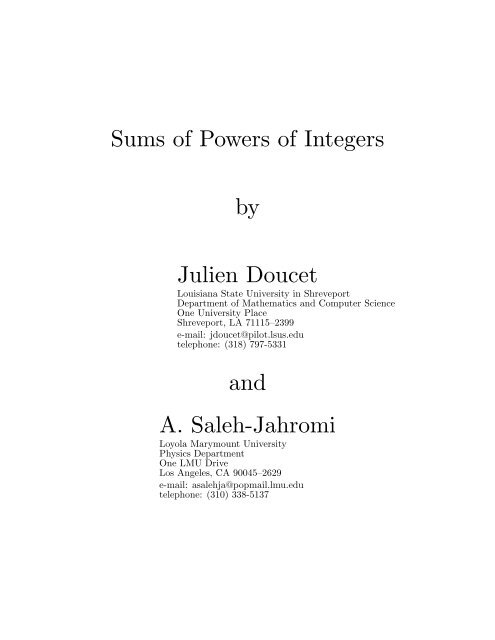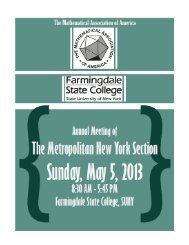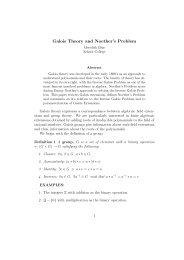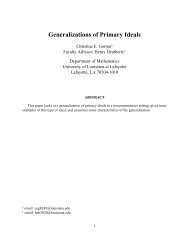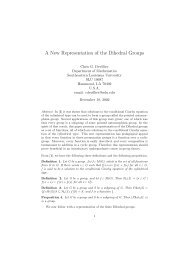Sums of Powers of Integers by Julien Doucet and A ... - MAA Sections
Sums of Powers of Integers by Julien Doucet and A ... - MAA Sections
Sums of Powers of Integers by Julien Doucet and A ... - MAA Sections
Create successful ePaper yourself
Turn your PDF publications into a flip-book with our unique Google optimized e-Paper software.
<strong>Sums</strong> <strong>of</strong> <strong>Powers</strong> <strong>of</strong> <strong>Integers</strong><br />
<strong>by</strong><br />
<strong>Julien</strong> <strong>Doucet</strong><br />
Louisiana State University in Shreveport<br />
Department <strong>of</strong> Mathematics <strong>and</strong> Computer Science<br />
One University Place<br />
Shreveport, LA 71115–2399<br />
e-mail: jdoucet@pilot.lsus.edu<br />
telephone: (318) 797-5331<br />
<strong>and</strong><br />
A. Saleh-Jahromi<br />
Loyola Marymount University<br />
Physics Department<br />
One LMU Drive<br />
Los Angeles, CA 90045–2629<br />
e-mail: asalehja@popmail.lmu.edu<br />
telephone: (310) 338-5137
Abstract<br />
The Edwards-Owens-Bloom Algorithm provides a simple technique which generates<br />
formulae for the sum <strong>of</strong> powers <strong>of</strong> integers. These formulae up to degree 17 were published<br />
in the early 17th Century without leaving any records <strong>of</strong> how they were derived.<br />
We<br />
present a pro<strong>of</strong> <strong>of</strong> the Algorithm using simple techniques which where known during that<br />
era.
<strong>Sums</strong> <strong>of</strong> <strong>Powers</strong> <strong>of</strong> <strong>Integers</strong><br />
<strong>Julien</strong> <strong>Doucet</strong> <strong>and</strong> A. Saleh-Jahromi<br />
1. Introduction. Sometime ago, we became interested in the sums <strong>of</strong> powers <strong>of</strong><br />
integers. One usually sees these formulae in developing the concept <strong>of</strong> Riemann <strong>Sums</strong> for<br />
the definite integral while teaching Calculus. The following are some <strong>of</strong> these sums:<br />
n∑<br />
1 = n, (1)<br />
j=1<br />
n∑<br />
j<br />
j=1<br />
n∑<br />
j=1<br />
n∑<br />
j=1<br />
n∑<br />
j=1<br />
n∑<br />
j=1<br />
= n(n+1)<br />
2<br />
= 1 2 n2 + 1 2n, (2)<br />
j 2 = n(n+1)(2n+1)<br />
6<br />
= 1 3 n3 + 1 2 n2 + 1 6n, (3)<br />
j 3 = n2 (n+1) 2<br />
4<br />
= 1 4 n4 + 1 2 n3 + 1 4 n2 , (4)<br />
j 4 = n(n+1)(2n+1)(3n2 +3n−1)<br />
30<br />
= 1 5 n5 + 1 2 n4 + 1 3 n3 − 1<br />
30n, (5)<br />
.<br />
j p = 1<br />
p+1 np+1 + 1 2 np + (lower powers <strong>of</strong> n). (6)<br />
These are found in most Calculus books to compute areas. They are usually used to<br />
∫ b<br />
develop the integral formula x n dx = bn+1 − a n+1<br />
for integers n =0, 1, 2, 3, 4,...,p.<br />
a<br />
n +1<br />
These sums are used in analyzing the number <strong>of</strong> operations needed to solve linear equations<br />
<strong>by</strong> Gaussian elimination. ( See [10]. )<br />
We became interested in finding a method to derive a formula for the finite sums<br />
n∑<br />
<strong>of</strong> powers <strong>of</strong> integers, j p (where p is a non-negative integer), as a polynomial in terms<br />
j=1<br />
<strong>of</strong> n. Itturns out that we can find a polynomial <strong>of</strong> degree p+1 that will do the job., i.e., for<br />
integers n ≥ 0,p≥ 0,<br />
n∑<br />
∑p+1<br />
j p = P p (n) ≡ a p j nj (7)<br />
j=1<br />
or<br />
j=0<br />
1 p +2 p +3 p + ...+ n p = P p (n) ≡ a p p+1 np+1 + a p pn p + a p p−1 np−1 + ...+ a p 2 n2 + a p 1 n + ap 0<br />
for some polynomial <strong>of</strong> n, P p (n), <strong>of</strong> degree p +1 with (rational) coefficients a p p+1 ,ap p,a p p−1 ,<br />
1
...,a p 2 ,ap 1 ,ap 0 . Methods using finite differences can be used to develop these formulae in<br />
n∑<br />
general. We will derive formulae for j p (for integers p ≥ 0) expressed as a polynomial<br />
j=1<br />
<strong>of</strong> degree p +1 using the simplest technique. And we will show how to apply a simple<br />
algorithm to generate the coefficients <strong>of</strong> the polynomials.<br />
One could generate these formulae <strong>and</strong> then use finite mathematical induction to prove<br />
them, case <strong>by</strong> case. Usually, one verifies the formulae (1)–(6), using finite mathematical<br />
induction in a Calculus course. In general, this could be done for the formula (7) after the<br />
coefficients are determined. But the question that remains is how to determine the values<br />
<strong>of</strong> the coefficients.<br />
Johann Faulhaber published formulae for (7) up to p =17in1631 without leaving<br />
any record <strong>of</strong> how he developed these formulae. See [6] p. 119. We give the formulae up<br />
to p =5below.<br />
n∑<br />
1 = n<br />
j=1<br />
n∑<br />
j<br />
j=1<br />
= 1 2 n2 + 1 2 n<br />
n∑<br />
j 2 = 1 3 n3 + 1 2 n2 + 1 6 n<br />
j=1<br />
n ∑<br />
j=1<br />
n∑<br />
j=1<br />
n∑<br />
j=1<br />
j 3 = 1 4 n4 + 1 2 n3 + 1 4 n2<br />
j 4 = 1 5 n5 + 1 2 n4 + 1 3 n3 − 1<br />
30 n<br />
j 5 = 1 6 n6 + 1 2 n5 + 5<br />
12 n4 − 1<br />
12 n2<br />
Methods using finite differences, factorial polynomials, <strong>and</strong> summations could generate<br />
these formulae. A good presentation <strong>of</strong> this is in [8] p. 22–42. Fortunately, there is a<br />
simple algorithm which will generate these formulae. See [2], p.304–305. Robert W.<br />
Owens in [7] <strong>and</strong> David Bloom in [2] revealed this algorithm that is very briefly given<br />
in [4]. We shall refer to that algorithm as the Edwards-Owens-Bloom Algorithm in this<br />
paper. As far as we have been able to determine from present day literature on the subject,<br />
it is derived using differentiation, Bernoulli numbers, <strong>and</strong> other methods <strong>and</strong> techniques<br />
which were not known in the early 17th Century. In this article, we shall try to derive<br />
the algorithm using simpler methods <strong>and</strong> techniques which were well understood during<br />
Faulhaber’s time.<br />
2
∑p+1<br />
The st<strong>and</strong>ard formula for P p (n) isP p (n) = a p j nj , where a p j<br />
j=1<br />
= Cp j−1 B p+1−j<br />
j<br />
1 ≤ j ≤ p+1 for all p ≥ 0, where B k are the Bernoulli numbers. In [7], Owens gives a pro<strong>of</strong><br />
for the algorithm using the Binomial Theorem, mathematical induction, differentiation,<br />
<strong>and</strong> the fact that two polynomials agreeing at infinitely many points must be identical. In<br />
[2], Bloom gives a simple pro<strong>of</strong> for this algorithm using Bernoulli numbers.<br />
Inductive arguments was used for arithmetic sequences <strong>and</strong> sums <strong>of</strong> integral cubes<br />
<strong>and</strong><br />
<strong>by</strong> Abū Bakr al-Karajī (c. 1000) <strong>and</strong> continued others ( [5] p. 255 ) .<br />
Levi ben Gerson<br />
(1288–1344) used the essentials <strong>of</strong> the method <strong>of</strong> induction involving combinatorics <strong>and</strong><br />
sums involving integers <strong>and</strong> powers ( [5] p. 302–304 ) . It appears that induction was well<br />
developed <strong>by</strong> 1653. It seems that Faulhaber would have been familiar with the process<br />
when he published his formulae.<br />
The Binomial Theorem was known in Europe as far back as 1527 ( [3] p. 421 ) . According<br />
to Smith, the triangular array called Pascal’s Triangle first appeared in print in<br />
1527 in a publication <strong>by</strong> Apianus. See [9] p. 508.<br />
2. Edwards-Owens-Bloom Algorithm. We shall now present some theorems <strong>and</strong><br />
their pro<strong>of</strong>s <strong>and</strong> develop the Edwards-Owens-Bloom Algorithm.<br />
n∑<br />
n∑<br />
Lemma 1. Forany constant k <strong>and</strong> any integer n ≥ 0, k = kn. Inparticular, 1=n.<br />
j=1<br />
j=1<br />
The pro<strong>of</strong> <strong>of</strong> the following theorem was suggested to us. It is Pascal’s 1654 pro<strong>of</strong>. ( See<br />
[1] p. 202. ) It is better <strong>and</strong> more illuminating than the pro<strong>of</strong> that we had given originally.<br />
Students may find it a good exercise to prove it formally <strong>by</strong> finite induction.<br />
Theorem 1. (i) For any polynomial Q <strong>of</strong> degree q, there exists a polynomial R such that<br />
n∑<br />
Q(j) =R(n) for n ≥ 0 <strong>and</strong> deg(R) =q +1.<br />
j=1<br />
(ii) In particular, for p, n ≥ 0, there exists a polynomial P p such that<br />
n∑<br />
j p = P p (n) <strong>and</strong> deg ( )<br />
P p = p +1.<br />
j=1<br />
3
We shall use the following convention in the material below. Let p, n be integers such<br />
n∑<br />
that p, n ≥ 0. From Theorem 1, we have j p = P p (n) for some polynomial P p <strong>of</strong> degree<br />
j=1<br />
p +1. So, P p (x) =a p p+1 xp+1 + a p px p + a p p−1 xp−1 + ...+ a p 2 x2 + a p 1 x + ap 0 for some constants<br />
a p p+1 ,ap p,a p p−1 ,...,ap 2 ,ap 1 ,ap 0 <strong>and</strong> ap p+1 ≠0. The coefficients <strong>of</strong> P p(x), a p j (0 ≤ j ≤ p + 1),<br />
n∑<br />
must be unique, since j p = P p (n) holds for at least 0 ≤ n ≤ p +2.<br />
j=1<br />
The results <strong>of</strong> Theorem 2 below is not new but we shall prove it in a new manner<br />
which will require simple algebraic manipulations <strong>and</strong> finite induction only. We present<br />
several lemmata prior to the theorem.<br />
Lemma 2. Forany integers n, p ≥ 0:<br />
Pro<strong>of</strong>: We have<br />
n+1<br />
∑<br />
j p =<br />
j=1<br />
p+1<br />
p∑<br />
(a p j + Cp j )nj + a p p+1 np+1 . (8)<br />
j=0<br />
n∑<br />
∑<br />
j p = P p (n) = a p j nj for 0 ≤ n, p. (9)<br />
j=1<br />
j=0<br />
Then, it follows from (9) that<br />
n+1<br />
∑ n∑<br />
∑p+1<br />
j p = j p +(n +1) p = P p (n)+(1+n) p = a p j nj +<br />
j=1<br />
=<br />
=<br />
j=1<br />
p∑<br />
a p j nj + a p p+1 np+1 +<br />
j=0<br />
p∑<br />
C p j nj =<br />
j=0<br />
p∑<br />
(a p j + Cp j )nj + a p p+1 np+1 .<br />
j=0<br />
Lemma 3. Forany integers n, p ≥ 0:<br />
j=0<br />
p∑<br />
C p j 1p−j n j<br />
j=0<br />
p∑<br />
(a p j nj + C p j nj )+a p p+1 np+1<br />
j=0<br />
n+1<br />
∑<br />
j p =<br />
j=1<br />
p∑ ∑p+1<br />
a p k Ck j nj + a p p+1 np+1 . (10)<br />
j=0 k=j<br />
Pro<strong>of</strong>: Now, it also follows from (9) in Lemma 2 that<br />
(<br />
n+1<br />
∑<br />
∑p+1<br />
j p = P p (n +1)= a p j (n ∑p+1<br />
+1)j = a p j (1 + ∑p+1<br />
n)j =<br />
j=1<br />
=<br />
=<br />
∑p+1<br />
j=0 k=0<br />
p+1<br />
j=0<br />
j=0<br />
j∑ ∑p+1<br />
∑p+1<br />
∑p+1<br />
∑p+1<br />
a p j Cj k nk = a p j Cj k nk =<br />
p∑ ∑<br />
a p k Ck j nj + a p p+1 Cp+1<br />
j=0 k=j<br />
j=0<br />
a p k Ck j nj<br />
k=0 j=k<br />
j=0 k=j<br />
p∑ ∑p+1<br />
p+1 np+1 =<br />
j=0 k=j<br />
a p j<br />
k=0<br />
)<br />
j∑<br />
C j k 1j−k n k<br />
a p k Ck j nj + a p p+1 np+1 .<br />
[<br />
p+1<br />
Lemma 4. Forintegers j, p such that 1 ≤ j ≤ p +1: a p j = 1 j<br />
C p j−1 − ∑<br />
4<br />
k=j+1<br />
C k j−1 ap k<br />
]<br />
. (11)
Pro<strong>of</strong>: Combining Lemmata 2 <strong>and</strong> 3, i.e., (8) <strong>and</strong> (10), we get:<br />
p∑<br />
p∑<br />
(a p j + ∑p+1<br />
Cp j )nj + a p p+1 np+1 = a p k Ck j nj + a p p+1 np+1 for 0 ≤ n, p.<br />
j=0<br />
k=j<br />
j=0 k=j<br />
By equating coefficients <strong>of</strong> like terms <strong>of</strong> n j ,weget for 0 ≤ j ≤ p:<br />
p+1<br />
a p j + Cp j = ∑<br />
p+1<br />
a p k Ck j = ap j · 1+ap j+1 · (j +1)+ ∑<br />
p+1<br />
a p k Ck j = ap j +(j +1)ap j+1 + ∑<br />
a p k Ck j .<br />
k=j+2<br />
k=j+2<br />
p+1<br />
Then, C p j =(j +1)ap j+1 + ∑<br />
p+1<br />
a p k Ck j <strong>and</strong> (j +1)ap j+1 = Cp j − ∑<br />
[<br />
p+1<br />
j +1,weget a p j+1 = 1<br />
j+1<br />
C p j − ∑<br />
j +1with j, weget (11).<br />
k=j+2<br />
a p k Ck j<br />
k=j+2<br />
a p k Ck j<br />
k=j+2<br />
. Dividing <strong>by</strong><br />
]<br />
for 0 ≤ j ≤ p or 1 ≤ j +1≤ p +1. Replacing<br />
Lemma 5. Forintegers k <strong>and</strong> p such that 0 ≤ k ≤ p: a p+1<br />
p+2−k = p+1<br />
p+2−k ap p+1−k . (12)<br />
Pro<strong>of</strong>: We will prove Lemma 5, i.e., (12) <strong>by</strong> strong induction on k.<br />
Let 0 ≤ p. Then 1 ≤ p +1.From Lemma 4, i.e., (11), we have:<br />
[<br />
]<br />
a p p+1 = ∑p+1<br />
1<br />
p+1<br />
Cp p − Cp k a p k<br />
= 1<br />
1<br />
p+1<br />
[1 − 0] =<br />
p+1 · 1= 1<br />
p+1 . Therefore,<br />
k=p+2<br />
a p+1<br />
p+2 = 1<br />
p+2 = p+1<br />
p+2 · 1<br />
p+1 = p+1<br />
p+2 · ap p+1 . Hence, (12) holds for 0 = k ≤ p.<br />
Suppose (12) holds for all k such that 0 ≤ k ≤ K. It suffices to show that (12) then<br />
holds for k = K +1. Let K +1≤ p. Then 0 ≤ k ≤ K
=<br />
1<br />
p+1−K<br />
=<br />
1<br />
p+1−K<br />
=<br />
1<br />
p+1−K<br />
[<br />
[<br />
[<br />
K<br />
(p+1)!<br />
(K+1)! (p−K)! − ∑<br />
(p+2−l)!<br />
(K−l+2)! (p−K)!<br />
l=0<br />
p+1<br />
(p+1)!<br />
(K+1)! (p−K)! − ∑<br />
(1+l)!<br />
(K+l−p+1)! (p−K)!<br />
l=p−K+1<br />
(p+1)<br />
(p−K)<br />
= (p+1) 1<br />
(p+1−K) (p−K)<br />
p!<br />
(K+1)! (p−K−1)! − (p+1)<br />
(p−K)<br />
[<br />
p+1<br />
C p p−K−1 − ∑<br />
l=p−K+1<br />
(p+1)<br />
(p+2−l) ap p+1−l<br />
∑p+1<br />
(p+1)<br />
(1+l) ap l<br />
] {since<br />
(12) holds<br />
for 0 ≤ l ≤ K<br />
]<br />
l!<br />
(K+l−p+1)! (p−K−1)! ap l<br />
l=p−K+1<br />
C l p−K−1 ap l<br />
= (p+1)<br />
(p+1−K) ap p−K<br />
<strong>by</strong> (11) <strong>and</strong> (15)<br />
=<br />
p+1<br />
p+2−(K+1) ap p+1−(K+1)<br />
Hence, (12) is true for k = K +1.<br />
Theorem 2. If 0 ≤ p <strong>and</strong> 1 ≤ j ≤ p +1,then a p+1<br />
j+1 = p+1<br />
j+1 ap j .<br />
Pro<strong>of</strong>: Letting j = p +1− k in Lemma 5, i.e., (12), we get:<br />
a p+1<br />
j+1 = ap+1 p+2−k = p+1<br />
p+2−k ap p+1−k = p+1<br />
j+1 ap j<br />
]<br />
for 0 ≤ K +1≤ p <strong>by</strong> (13).<br />
for 0 ≤ k ≤ p.<br />
But, 0 ≤ k ≤ p ⇐⇒ −p ≤ −k ≤ 0 ⇐⇒ −p + p +1 ≤ −k + p +1 ≤ 0+p +1<br />
⇐⇒ 1 ≤ p +1− k ≤ p +1 ⇐⇒ 1 ≤ j ≤ p +1. Hence, a p+1<br />
j+1 = p+1<br />
j+1 ap j<br />
]<br />
for 1 ≤ j ≤ p +1.<br />
The following theorems <strong>and</strong> corollary do not yield new results. Their pro<strong>of</strong>s are short<br />
<strong>and</strong> require little effort with the above results.<br />
Theorem 3. For any p ≥ 0, a p 0 =0.<br />
n∑<br />
∑p+1<br />
Pro<strong>of</strong>: We have j p = P p (n) = a p j nj for 0 ≤ n, p. Setting n =0,weget a p 0 =0.<br />
j=1<br />
j=0<br />
∑p+1<br />
Theorem 4. For any p ≥ 0, a p j =1.<br />
j=1<br />
n∑ ∑p+1<br />
∑p+1<br />
Pro<strong>of</strong>: By Theorem 3, j p = a p j nj for 0 ≤ n, p. Setting n =1,weget a p j =1.<br />
j=1 j=1<br />
j=1<br />
p+1<br />
Corollary 1. For any p ≥ 0, a p 1 =1− ∑<br />
a p j .<br />
j=2<br />
6
∑p+1<br />
Using Theorem 4, we get P p (n) = a p j nj =<br />
0 ≤ p. Hence,<br />
j=0<br />
∑p+1<br />
p+1<br />
a p j nj +a p 0 = ∑ ∑p+1<br />
a p j nj +0 = a p j nj for<br />
j=1<br />
n∑<br />
∑p+1<br />
j p =P p (n)= a p j nj =a p p+1 xp+1 +a p px p +a p p−1 xp−1 +...+a p 3 x3 +a p 2 x2 +a p 1 x<br />
j=1<br />
j=1<br />
for 0 ≤ n, p. Using Theorem 2 <strong>and</strong> Corollary 1, we can develop the Edwards-Owens-Bloom<br />
Algorithm. The Edwards-Owens-Bloom Algorithm generates the coefficients <strong>of</strong> P p+1 (n)<br />
from the coefficients <strong>of</strong> P p (n) for p ≥ 0. The algorithm is as follows:<br />
The Edwards-Owens-Bloom Algorithm<br />
∑p+1<br />
(1) Given: P p (n) = a p j nj with known coefficients a p j (1 ≤ j ≤ p + 1).<br />
(2) Multiply each a p j<br />
j=1<br />
p+1<br />
<strong>by</strong><br />
j+1<br />
to produce ap+1 j+1<br />
j=1<br />
j=1<br />
(1 ≤ j ≤ p + 1). This will generate the<br />
coefficients <strong>of</strong> P p+1 (n): a p+1<br />
j for 2 ≤ j ≤ p +2. All <strong>of</strong> the coefficients <strong>of</strong> P p+1 (n) will<br />
have been determined, except for a p+1<br />
1 .<br />
(3) To produce the last (missing) coefficient <strong>of</strong> P p+1 (n), a p+1<br />
1 :<br />
(a) add all <strong>of</strong> the coefficients <strong>of</strong> P p+1 (n) generated in Step (2);<br />
(b) subtract the sum in (a) from 1; <strong>and</strong><br />
(c) a p+1<br />
1 is the resultant difference produced in (b).<br />
The above algorithm is illustrated in the diagram below.<br />
a p p+1x p+1 + a p px p + a p p−1x p−1 + ...+ a p j<br />
x j + ...+ a p 3x 3 + a p 2x 2 + a p 1x<br />
⏐<br />
↓ × p+1<br />
p+2<br />
⏐<br />
↓ × p+1<br />
p+1<br />
⏐<br />
↓ × p+1<br />
p<br />
··· ⏐<br />
↓ × p+1<br />
j+1<br />
··· ⏐<br />
↓ × p+1<br />
4<br />
⏐<br />
↓ × p+1<br />
3<br />
⏐<br />
↓ × p+1<br />
2<br />
a p+1<br />
p+2x p+2 + a p+1x p+1 + a p+1<br />
p<br />
x p + ...+ a p+1<br />
j+1x j+1 + ...+ a p+1<br />
4<br />
x 4 + a p+1<br />
3<br />
x 3 + a p+1<br />
2<br />
x 2 + a p+1<br />
1<br />
x<br />
||<br />
{ }} {<br />
∑p+2<br />
1 −<br />
a p+1<br />
j<br />
j=2<br />
3. Epilogue. In [7], Owens used the binomial theorem, mathematical induction,<br />
<strong>and</strong> differentiation to derive the Edwards-Owens-Bloom Algorithm. In [2], Bloom used<br />
Bernoulli numbers to justify the algorithm.<br />
In our opinion, Faulhaber could not have<br />
7
derived the algorithm as did Owens in [7] <strong>and</strong> as did Bloom in [2]. In this article, the<br />
formulae for (7) could be derived <strong>by</strong> using finite differences. This method can be continued<br />
to derive the formula in (7) for any arbitrarily fixed integer p ≥ 0. The Edwards-Owens-<br />
Bloom Algorithm was derived in this article using simple methods, i.e., using algebraic<br />
manipulations which were well understood in the 17th Century. Perhaps, he used method<br />
<strong>of</strong> finite differences or, as we think more likely, he developed the Edwards-Owens-Bloom<br />
Algorithm which could have been derived using the algebraic manipulations in Lemma 1,<br />
Theorem 1, Lemmata 2–5, Theorems 2–4, <strong>and</strong> Corollary 1.<br />
Acknowledgments.<br />
We wish to thank George Boros, Carlos G. Spaht II, Dan<br />
Kalman, <strong>and</strong> Carl Libis for their encouragement to further investigate this topic <strong>and</strong> to<br />
write an article on it.<br />
George Boros was particularly helpful to us with some <strong>of</strong> the<br />
reference materials. Carl Libis pointed out some minor errors in this article <strong>and</strong> expressed<br />
some <strong>of</strong> his opinions about the material <strong>and</strong> history involved. We are grateful to him for<br />
his help <strong>and</strong> suggestions. Also, we wish to express our appreciation for suggestions for<br />
some improvements from an anonymous person.<br />
References<br />
[1] Alan F. Beardon, <strong>Sums</strong> <strong>of</strong> powers <strong>of</strong> integers, The American Mathematical Monthly<br />
103 (1996), 201–213.<br />
[2] David M. Bloom, An old algorithm for the sums <strong>of</strong> integer powers, Mathematics<br />
Magazine 66 (1993), 304–305.<br />
[3] Carl B. Boyer, A history <strong>of</strong> mathematics, John Wiley & Sons, Inc., New York, New<br />
York, 1968.<br />
[4] Harold M. Edwards, Fermat’s last theorem: a genetic introduction to algebraic number<br />
theory, Springer-Verlag, Inc., New York, New York, 1977.<br />
[5] Howard Whitley Eves, An introduction to the history <strong>of</strong> mathematics, 5th ed., Saun-<br />
8
ders College Publishing, Philadelphia, Pennsylvania, 1983.<br />
[6] H. K. Krishnapriyan, Eulerian polynomials <strong>and</strong> Faulhaber’s result on sums <strong>of</strong> powers<br />
<strong>of</strong> integers, The College Mathematics Journal 26 (1995), 118–123.<br />
[7] Robert W. Owens, <strong>Sums</strong> <strong>of</strong> powers <strong>of</strong> integers, Mathematics Magazine 65 (1992),<br />
38–40.<br />
[8] Francis Scheid, Schaum’s outline <strong>of</strong> theory <strong>and</strong> problems <strong>of</strong> numerical analysis, 2nd<br />
ed., Mc-Graw-Hill, Inc., New York, New York, 1988.<br />
[9] David Eugene Smith, History <strong>of</strong> mathematics, Vol. II, Dover Publications, Inc., New<br />
York, New York, 1958.<br />
[10] Sidney Yakowitz <strong>and</strong> Ferenc Szidarovszky, An introduction to numerical computations,<br />
2nd ed., MacMillan Publishing Company, Inc., 1989, 67.<br />
9


